Guitar World Verdict
A tone-blending electro-acoustic hybrid that truly blurs the lines between electric and acoustic guitar, the Emerald Virtuo is designed for the adventurous player. It'll take some time to fathom but has rich, depths of tone just waiting to be discovered.
Pros
- +
Extremely versatile, with hundreds of sonic paths to explore.
- +
Lightweight.
- +
Playable with excellent upper-fret access.
Cons
- -
The shock of the new.
- -
Fiddly nature of mixing voices and MIDI might deter some.
You can trust Guitar World
The carbon-fibre guitar manufacturer Emerald is based in Donegal, Ireland, and has an immense range of instruments from straightforward acoustics to mighty harp guitars and beyond.
We last looked at a guitar from Emerald – the X10 Artisan Woody, to be precise – back in issue 456, and were impressed by the fact it not only felt and sounded like a regular acoustic guitar, but it also had amazing stability, both in terms of construction and its immunity to variations in humidity. It also held its tuning like a champ during the time we spent with it.
Emerald combines founder Alistair Hay’s interest in guitars and his background in polymer engineering, the latter seeing him forge a career making Formula One carbon-fibre racing boats before starting Emerald in 1999.
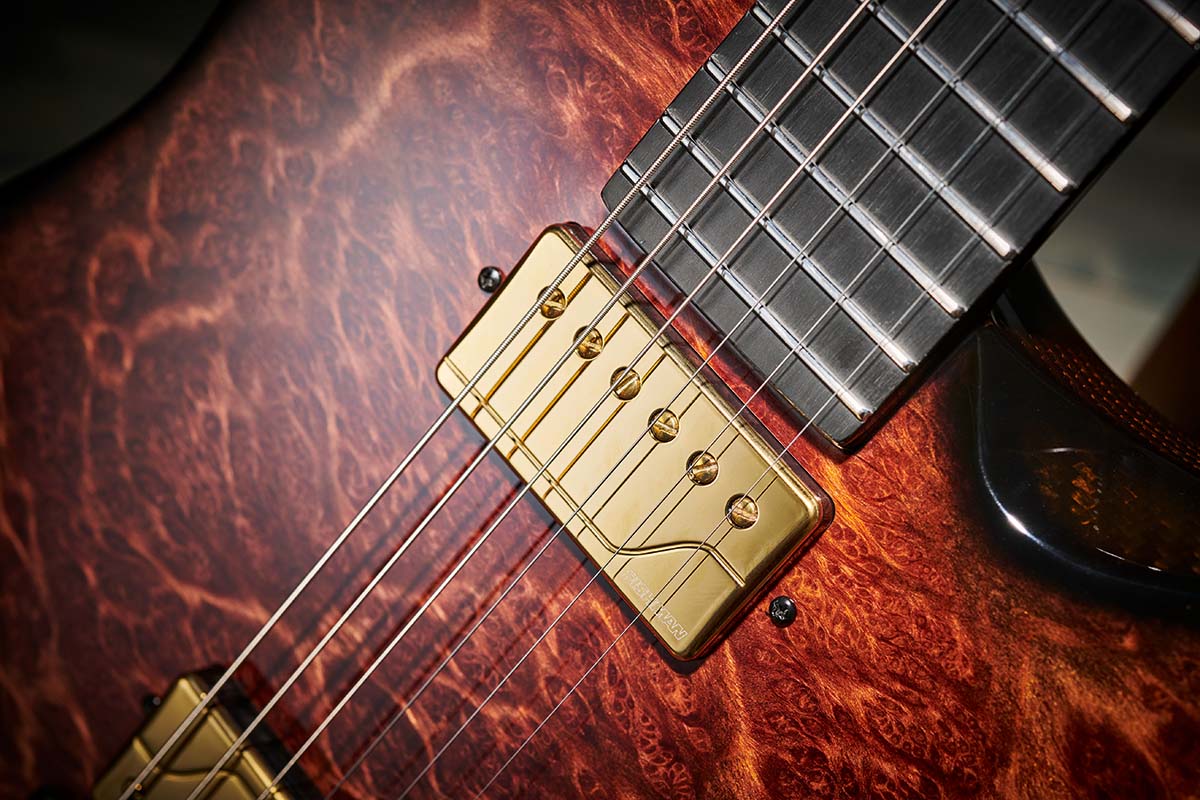
The X10 we looked at was basically an acoustic guitar that also had a humbucking pickup in the neck position, a Graph Tech Ghost piezo bridge and MIDI. This offered a vast blend of sounds that the player could employ in an acoustic performance should they choose.
The point we’re making here is that it was intrinsically an acoustic guitar. What we have before us today with the company’s brand-new Virtuo is Emerald’s step into the dual-humbucker electric-hollowbody market. Well, we say dual-humbucker, but there’s a lot more to this instrument’s sonic portfolio lurking under its redwood burl veneer.
Feel & Sounds
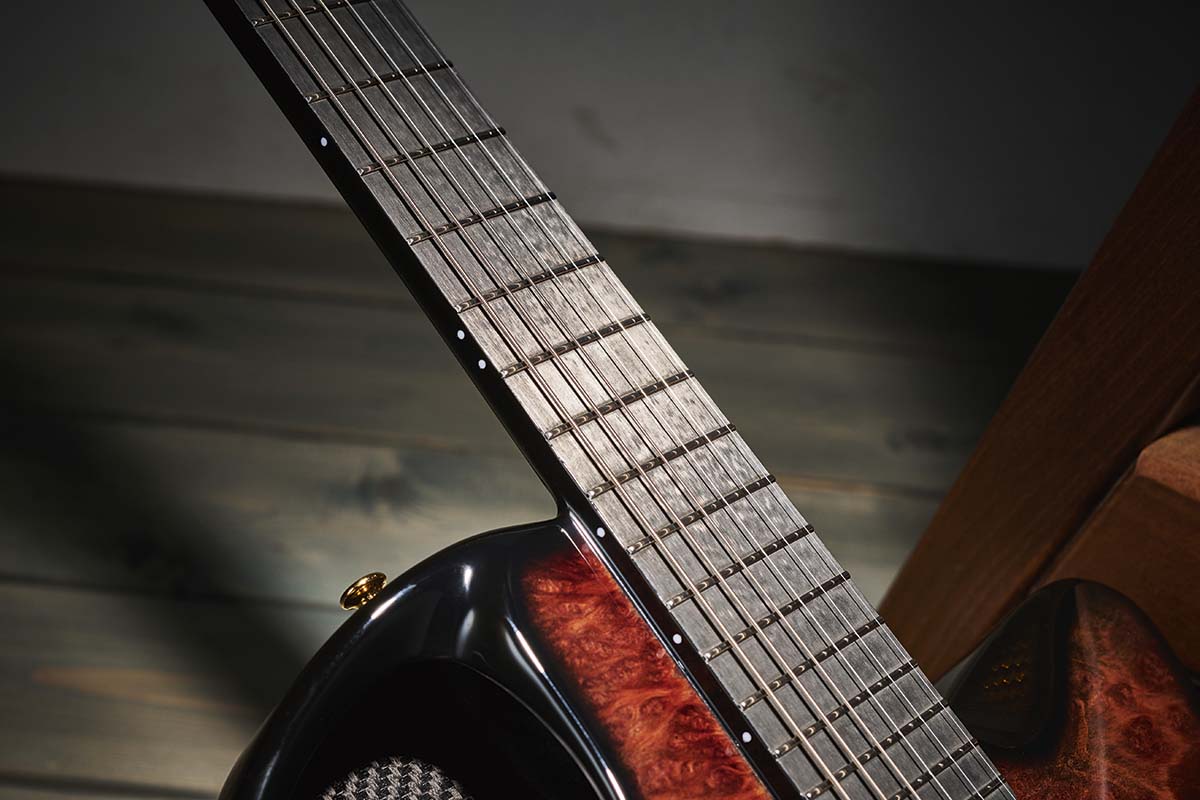
We admit we were scratching our heads a bit when we first opened the Virtuo’s plush Hiscox case. We wondered what kind of player the Virtuo is aimed at; an electric player who wants some of the attributes of an acoustic or the other way around? Or both?
According to Emerald, the Virtuo has, “The body of an acoustic… the soul of an electric. The Virtuo is an acoustic guitar with all the features of both an electric and an acoustic guitar. Ergonomically designed for comfort with a slim body, the Virtuo is an acoustic guitar made specifically with the electric player in mind.
The neck is slim and fast like an electric guitar and with its innovative neck-to-heel design it allows the player full 22-fret access to reach even those highest notes.” Okay, but we’re still not 100 per cent sure which way this particular coin lands. To start with, there’s the strings.
Our office micrometer tells us the gauge is a set of .009s and, with the scale length of 648mm (25.5 inches), you have an idea what the string tension is like. And, of course, they’re electric guitar strings so the humbuckers can work at their optimum level. An acoustic player is going to find these a tad flimsy if they are used to the .012 or .013 gauge found on the average flat top.
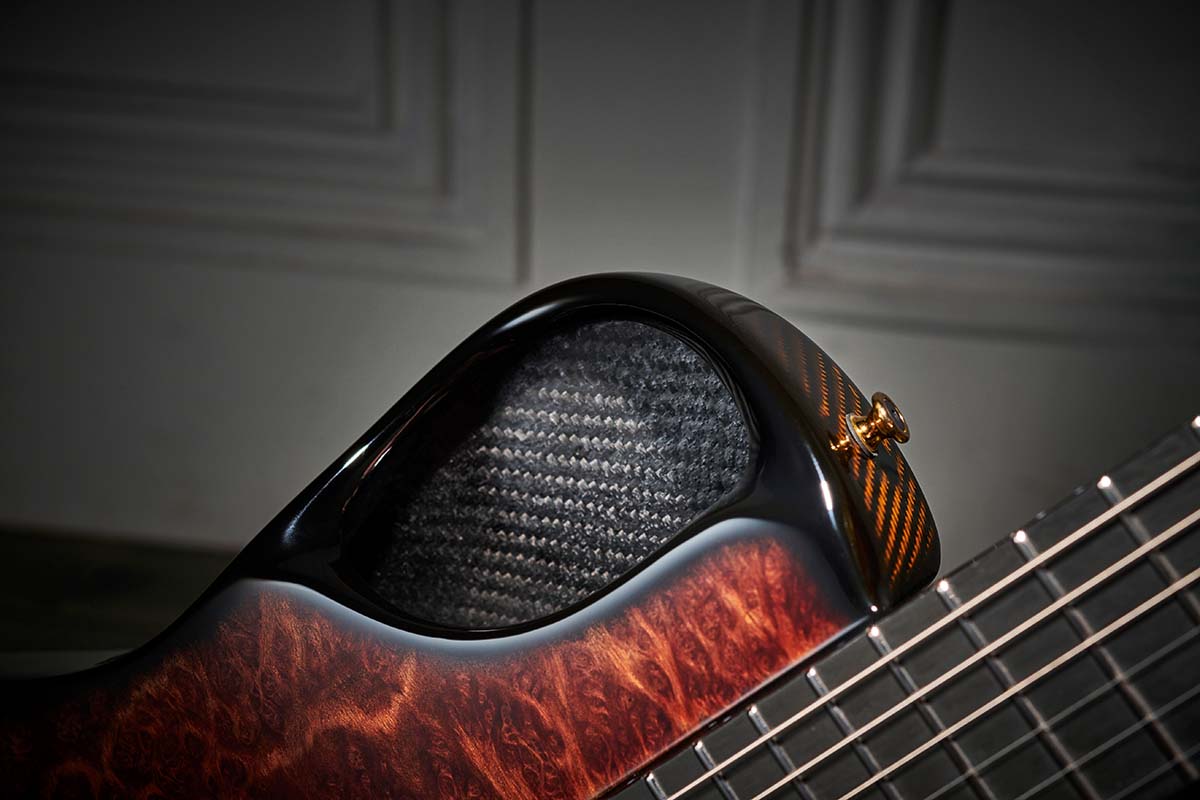
The actual acoustic – ie, unplugged – sound of the guitar is on the light side as a result of both the above, too. If you can imagine a quality electric archtop’s acoustic sound, you’re in the ballpark. All this is just an observation, you understand; an acoustic player with a taste in heavier gauge strings could easily fix a beefier set.
We’re merely trying to clear up the mystery of where this instrument fits into the guitar landscape. As far as the Virtuo’s spec goes, most of it can be dealt with pretty quickly by saying the body, neck, fingerboard, etc are all carbon fibre.
The ’board has 22 stainless-steel frets, the nut is Graph Tech and the string saddles are that same company’s Ghost Piezo unit, comprising six individual fully adjustable saddles, each of which is a separate sensor. This means the acoustic output of the Virtuo is hexaphonic, which accounts for the MIDI facility, dealt with via its own independent volume control and 13-pin Hexpander output to the side of the guitar.
For now, the MIDI side of the Virtuo will have to remain unexplored as we haven’t the facility to test it. In order to take advantage of it, you’d have to have access to something like a Roland guitar synth or Boss SY-1000.
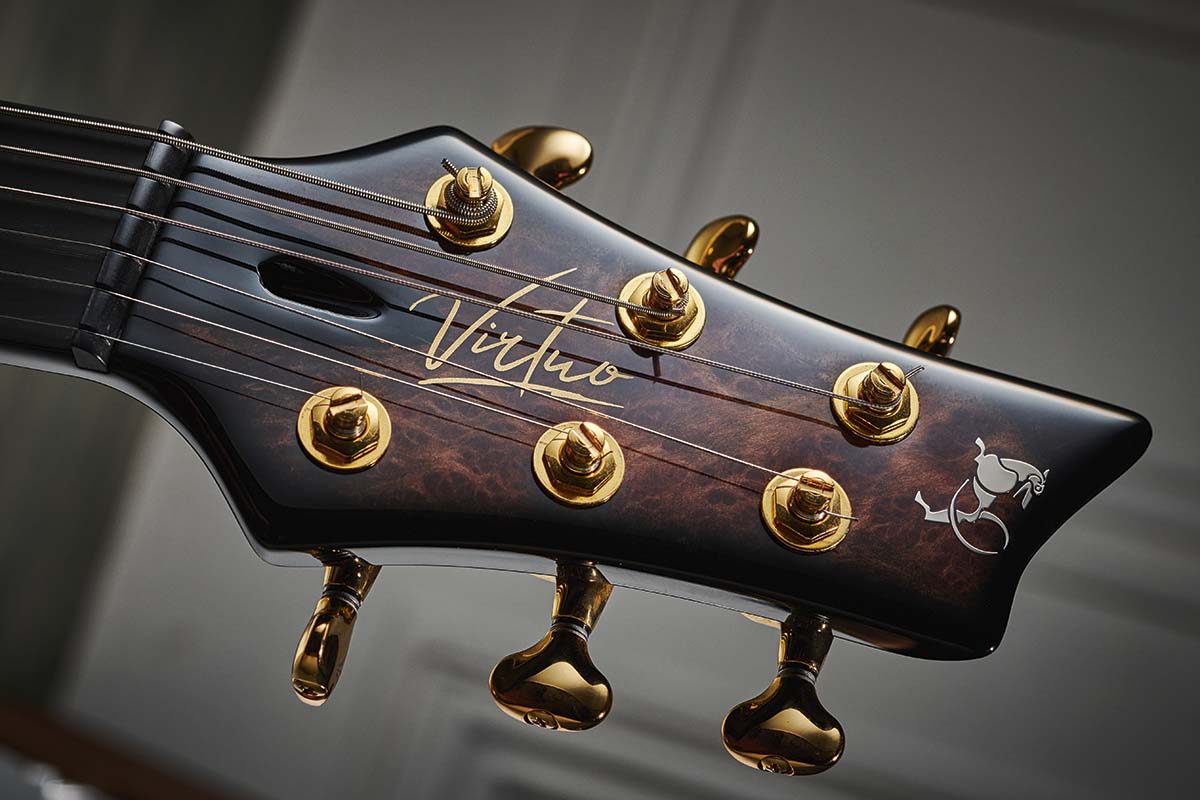
The humbuckers are Fishman Fluence with the dual identity of being switchable between vintage or hot-rod voices. They’re coil-splittable, too. Internal power is provided by a 9V battery on the guitar’s lower side.
If you’re doing the same sort of mental arithmetic that we are, you can imagine how many combinations of voices you can get from the Virtuo, making this an extremely versatile instrument and an open book for someone with enough creative flair to take full advantage of its many personalities. But how does it measure up as a workstation, plain and simple?
Picking the guitar up, the first thing we notice is the slimness of the neck. It’s not lolly-stick 80s Ibanez by any means, but it’s definitely looking in that direction. It’s about 20mm at the first fret and delivers the illusion that the nut is a lot wider than the 43mm mentioned in the guitar’s spec. But no, it’s 43mm (we measured) broadening to 62.28mm at the body end.
The neck join means the hand is never going to be hampered by obstacles while engaged in playing, either. Sitting or standing with the guitar is a comfortable experience – the guitar weighs a very trim 1.63kg (3lb) – lighter than our Admira nylon string – and won’t cause any strain at all during a long set.
Testing the sound of the Virtuo meant hooking it up sequentially to an AER Compact 60 first, in order to test the Ghost piezo. If you’ve ever experienced a piezo pickup on an electric guitar before, you’ll know the sound is thinner than it would be with fully fledged heavy-gauge phosphor-bronze strings.
Having said that, it would be possible to use this as a solo voice with some attention paid to the EQ to fill out the sound a little. We did fire up the humbuckers to see what was on offer there with a mix of the voices (not at all unreasonable as many jazz players employ an AER) and the piezo shone through, adding airiness and contour to the proceedings.
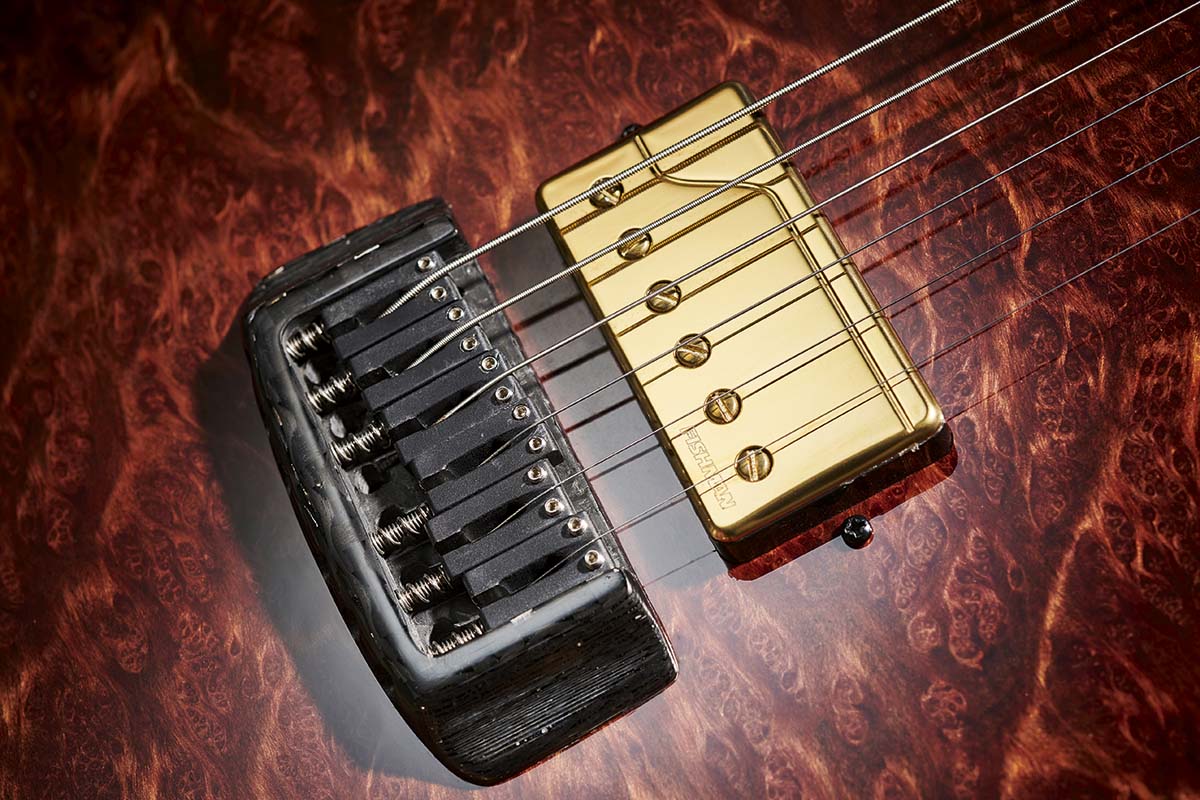
The control layout for the various sounds on offer takes a little getting used to, but after a few near misses, we found our feet and were blending sounds together with ease. In order to assess the guitar’s pure electric characteristics, we used a Blackstar combo and gave the humbuckers a spin in a more rock environment.
We’ve been impressed with Fishman’s Fluence pickups before and the same is true here. In vintage mode, the sounds are classic, but introduce a bit of fire under the bonnet and you’re into semi-solid territory, complete with bite and snap. Swapping over to the hod-rod setting and there’s even more sizzle to play with.
The single-coil mode also gives some very usable sounds, especially with both neck and bridge engaged. It was only after we’d packed our toys away that we realised we hadn’t encountered the beast that is feedback during our tests. True to say we weren’t playing at stadium levels, but we would have expected it to rear its head at least once.
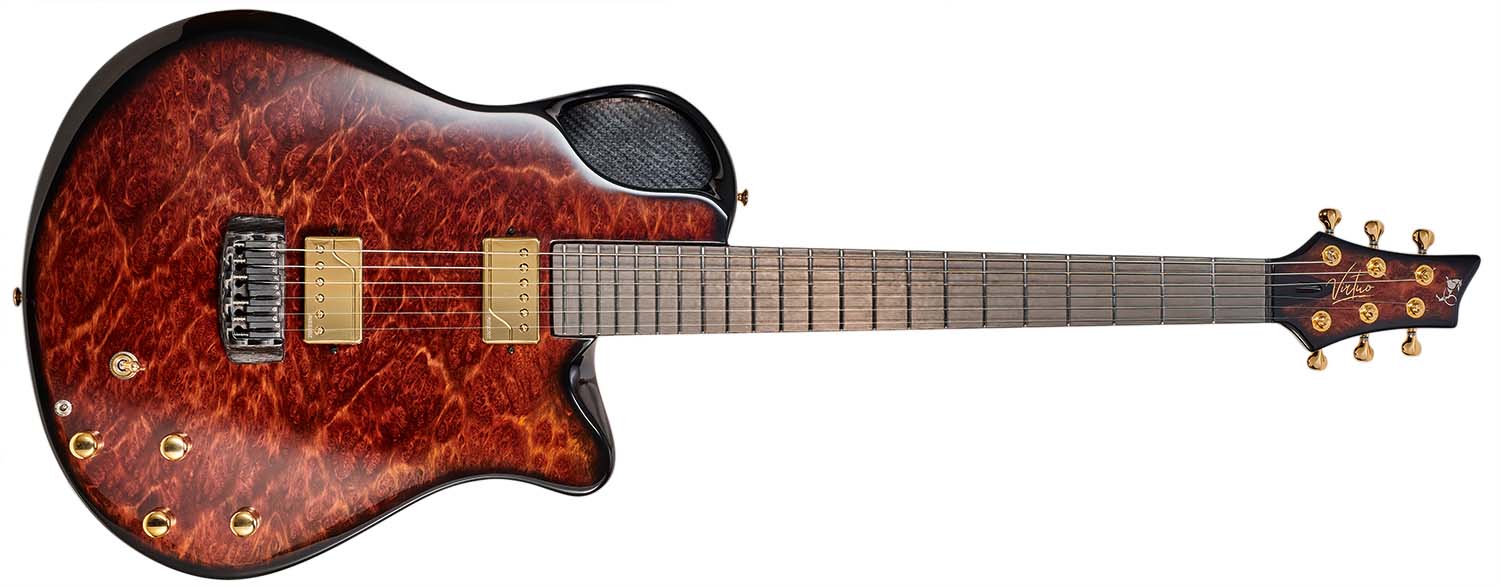
Verdict
It’s always going to be a challenge for anyone to assess a new instrument in such a short time. You’d need to spend a few weeks with the Virtuo in order to plumb its considerable depths. It’s largely unexplored territory, after all, and if you dial in the MIDI option that land is expanded further.
We’re still not entirely sure on which side of the acoustic/electric fence this guitar sits. It affects a compelling compromise between the two spheres of playing, for sure, but we feel an electric player might be more at home here than one whose mainstay is the acoustic. But if you’re willing to make the journey, the results could be very rewarding indeed.
Specs
- PRICE: £2,625 (inc hard case)
- ORIGIN: Donegal, Ireland
- TYPE: Electro-acoustic
- TOP: Carbon fibre (with redwood burl veneer)
- BACK/SIDES: Carbon fibre
- MAX RIM DEPTH: 69.85mm
- MAX BODY WIDTH: 375mm
- NECK: Carbon fibre
- SCALE LENGTH: 648mm (25.5”)
- TUNERS: Gotoh 510
- NUT/WIDTH: Graph Tech/43mm
- FINGERBOARD: Carbon fibre, 305- 406mm (12”-16”) compound radius
- FRETS: 22, stainless steel
- BRIDGE/SPACING: Carbon fibre with Graph Tech Ghost saddles/52.7mm
- ELECTRICS: Two Fishman Fluence pickups, Graph Tech Ghost Piezo and Hexpander MIDI output (via 13-pin socket)
- WEIGHT (LB/KG): 3/1.36
- OPTIONS: Basic model starts at £2,150. Various wood veneer tops and build variations. See website for details
- RANGE OPTIONS: Emerald has an extended range of electro acoustics, double-necks, 12-strings and harp guitars. See website for details
- LEFT-HANDERS: Yes
- FINISH: High gloss
- CONTACT: Emerald Guitars
With over 30 years’ experience writing for guitar magazines, including at one time occupying the role of editor for Guitarist and Guitar Techniques, David is also the best-selling author of a number of guitar books for Sanctuary Publishing, Music Sales, Mel Bay and Hal Leonard. As a player he has performed with blues sax legend Dick Heckstall-Smith, played rock ’n’ roll in Marty Wilde’s band, duetted with Martin Taylor and taken part in charity gigs backing Gary Moore, Bernie Marsden and Robbie McIntosh, among others. An avid composer of acoustic guitar instrumentals, he has released two acclaimed albums, Nocturnal and Arboretum.
The heaviest acoustic guitar ever made? Two budding builders craft an acoustic entirely from concrete because they “thought the idea was really funny”
“For years, the only 12-string acoustics I got my hands on, the necks always pulled off after a bit. I earned a lot of money replacing them!” Why one of the UK’s most prolific luthiers is a bolt-on acoustic die-hard












